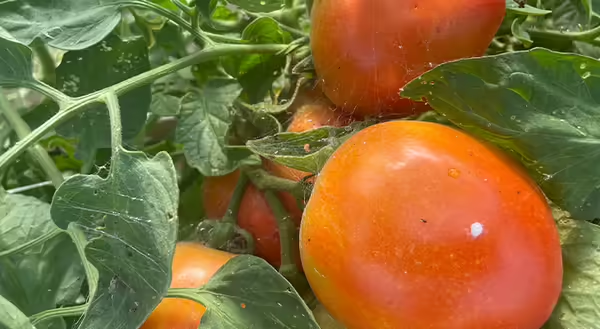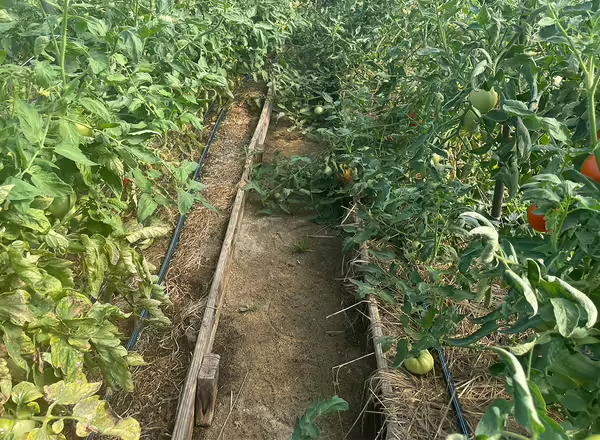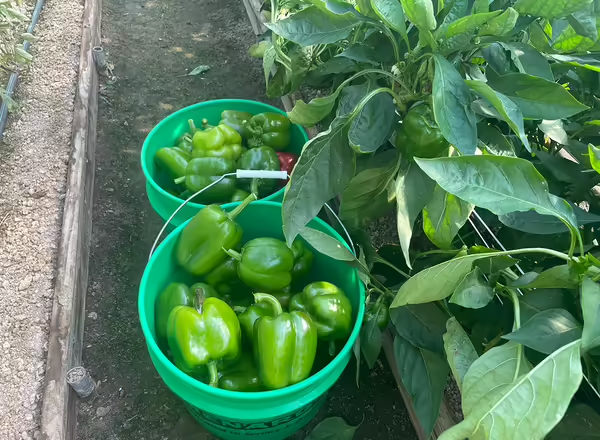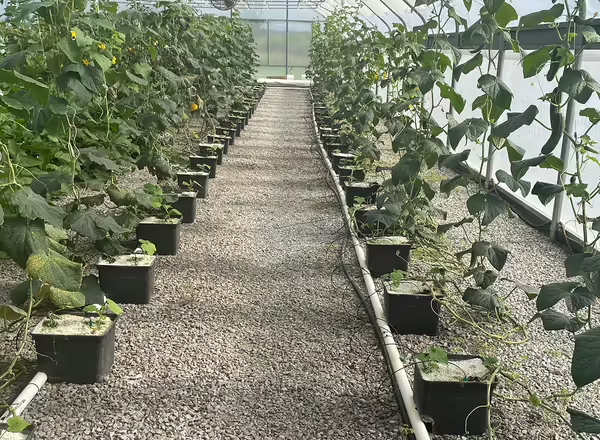
No-till cover crop observations
Predator insects continue to thrive in the treatment tunnel (cover crops + cut flowers), including the many small spiders. The number of webs within all the tomato and pepper plants is impressive, especially as pest insects can be observed stuck in the webs. The white egg masses of the spiders can also be seen among the plants, indicating they are happy in the environment.
In looking at the amount of residue left in the beds since cover crop termination, the beds that were solarized have less residue, which would be expected based on the difference in biomass growth between the time of solarization and mechanical termination, and some of these beds have no residue left at all. A comparison of annual ryegrass residue from a solarized plot (left row) and a mechanically terminated plot (right row) can be seen in the photo. The tomato plants in the row on the right appear to be greener, but the plant stems are smaller, and they yielded much less fruit than the plants in the row on the left.


Tomato and pepper harvest
Heavy tomato harvests lasted about four weeks, beginning the last week of June and running through the fourth week of July. With most of the fruit off the plants, a flush of new growth has begun on the tops of most varieties. From April 15 to July 15, fertilizers were applied through the drip irrigation system typically twice per week. Various water-soluble fertilizers were used including
- Potassium nitrate 13-0-45
- Calcium nitrate 15.5-0-0 with 19% Ca
- Potassium sulfate 0-0-45
- Ultrasol hydroponic fertilizer 3-15-28
- Magnesium sulfate 9.8% Mg & 12.9% S
Application rates varied between 0.5 lb to 1.5 lb of actual product depending on the product, fruit development stage, crop load, and plant signals, but most commonly, products were applied at 1.0 lb to 1.25 lb rates. Tomatoes are a heavy potassium feeder and generally require 3 times more potassium than nitrogen throughout the growing season. Total amount of fertilizer applied in the 90-day period in each high tunnel:
- 150 lb/A N nitrogen
- 80 lb/A P phosphorus
- 510 lb/A K potassium
- 120 lb/A Ca calcium
- 20 lb/A Mg magnesium
Pepper plants are continuing to set fruit and provide good quality fruit. Typically, bell peppers are harvested weekly while some of the other types may need to be walked through twice per week. In most years, high tunnel peppers will continue to yield good quality fruit into September/October, well after determinate tomato production has fallen off for the season.

Hydroponic tunnel
As a follow up to last month’s update on our cucumber planting, half of the original cucumber vines transplanted in April have been removed and new transplants were set out July 23. Instead of having to fill and place more dutch buckets, we opted to just remove the inside vine from each existing bucket and replace it with a new transplant. This will allow harvest to continue, albeit at half the volume, until the new transplants begin producing fruit. Once the new vines are in full production, the second set of original vines with be removed and replaced with new transplants. This change in planting from our normal routine has increased airflow at the most opportune time, as the oppressive heat and humidity make working within the cucumber vines physically challenging.